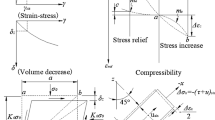Abstract
The quaternary deposits in Shanghai are horizontal soil layers of thickness up to about 280m in the urban area with an annual groundwater table between 0.5 and 0.7m from the surface. The characteristics of deep saturated deposits may have important influences upon seismic response of the ground in Shanghai. Based on the Biot theory for porous media, the water-saturated soil deposits are modeled as a two-phase porous system consisting of solid and fluid phases, in this paper. A nonlinear constitutive model for predicting the seismic response of the ground is developed to describe the dynamic characters of the deep-saturated soil deposits in Shanghai. Subsequently, the seismic response of a typical site with 280m deep soil layers, which is subjected to four base excitations (El Centro, Taft, Sunan, and Tangshan earthquakes), is analyzed in terms of an effective stress-based finite element method with the proposed constitutive model. Special emphasis is given to the computed results of accelerations, excess pore-water pressures, and settlements during the seismic excitations. It has been found that the analysis can capture fundamental aspects of the ground response and produce preliminary results for seismic assessment.








Similar content being viewed by others
References
Biot MA (1956) Theory of propagation of waves in a fluid saturated porous solid. J Acoust Soc Am 28:168–191
Editorial Committee of Shanghai Chorography (1999) Geology and mine records of Shanghai. Shanghai Academy of Social Sciences Press, Shanghai (in Chinese)
Finn WDL, Nichols AM (1988) Seismic response of long-period sites: lessons from the September 19, 1985, Mexican earthquake. Can Geotech J 25(1):128–137
Hardin BO (1978) The Nature of stress–strain behaviour of soils; state of the art report. In: Proceedings of ASCE specialty conference on earthquake engineering and soil dynamics, Pasadena. 1:3–90
Hardin BO, Drnevich VP (1972) Shear modulus and damping in soils; design equations and curves. J Soil Mech Found Eng Div ASCE 98(7):667–692
Huang Y (1999) Study on the vertical earthquake resistant behavior of building pile foundations, PhD thesis. Tongji University, China (in Chinese)
Lee MKW, Finn WDL (1978) DESRA-2: dynamic effective stress response analysis of soil deposits with energy transmitting boundary including assessment of liquefaction potential. In: Soil mechanics series No. 36, Department of Civil Engineering, University of British Columbia, Vancouver
Martin PP, Seed HB (1982) One-dimensional dynamic ground response analyses. J Geotech Eng Div ASCE 108(7):935–952
Ni SD, Siddharthan RV, Anderson JG (1997) Characteristics of nonlinear response of deep saturated soil deposits. Bull Seismol Soc Am 87(2):342–355
Schnabel PB, Lysmer J, Seed HB (1972) SHAKE: a computer program for earthquake response analysis of horizontally layered sites. In: Tech Rep UCB/EERC-71/12, University of California, Berkeley
Seed HB, Idriss IM (1969) Influence of soil conditions on ground motions during earthquakes. J Soil Mech Found Div ASCE 95(1):99–137
Seed HB, Martin PP, Lysmer J (1976) Pore-water pressure changes during soil liquefaction. J Soil Mech Found Div ASCE 102(4):323–346
Shanghai foundation design code (DGJ08-1999) (1999) The Shanghai engineering construction standard office, Shanghai (in Chinese)
Wang TL, Hu WY (1992) Seismic response analyses of Shanghai deposits. In: Gao DZ (ed) Theory and practice on soft soil foundation. China Architecture and Building Press, Beijing, pp 55–61 (in Chinese)
Zienkiewicz OC, Bettes P (1982) Soils and other saturated media under transient, dynamic conditions. General formulation and the validity of various simplifying assumptions. In: Pande GN, Zienkiewiecz OC (eds) Soil mechanics-transient and cyclic loads. Wiley, New York, pp 1–16
Zienkiewicz OC, Taylor RL (2000) The finite element method, vol 1. In: The basis, 5th edn. Butterworth-Heinemann, Oxford
Zienkiewicz OC, Chan AHC, Pastor M, Schrefler B, Shiomi T (1999) Computational geomechanics. Wiley, Chichester
Acknowledgments
This work was supported by Shanghai Leading Academic Discipline Project, Project Number: B308.
Author information
Authors and Affiliations
Corresponding author
Rights and permissions
About this article
Cite this article
Huang, Y., Ye, W. & Chen, Z. Seismic response analysis of the deep saturated soil deposits in Shanghai. Environ Geol 56, 1163–1169 (2009). https://doi.org/10.1007/s00254-008-1216-1
Received:
Accepted:
Published:
Issue Date:
DOI: https://doi.org/10.1007/s00254-008-1216-1




